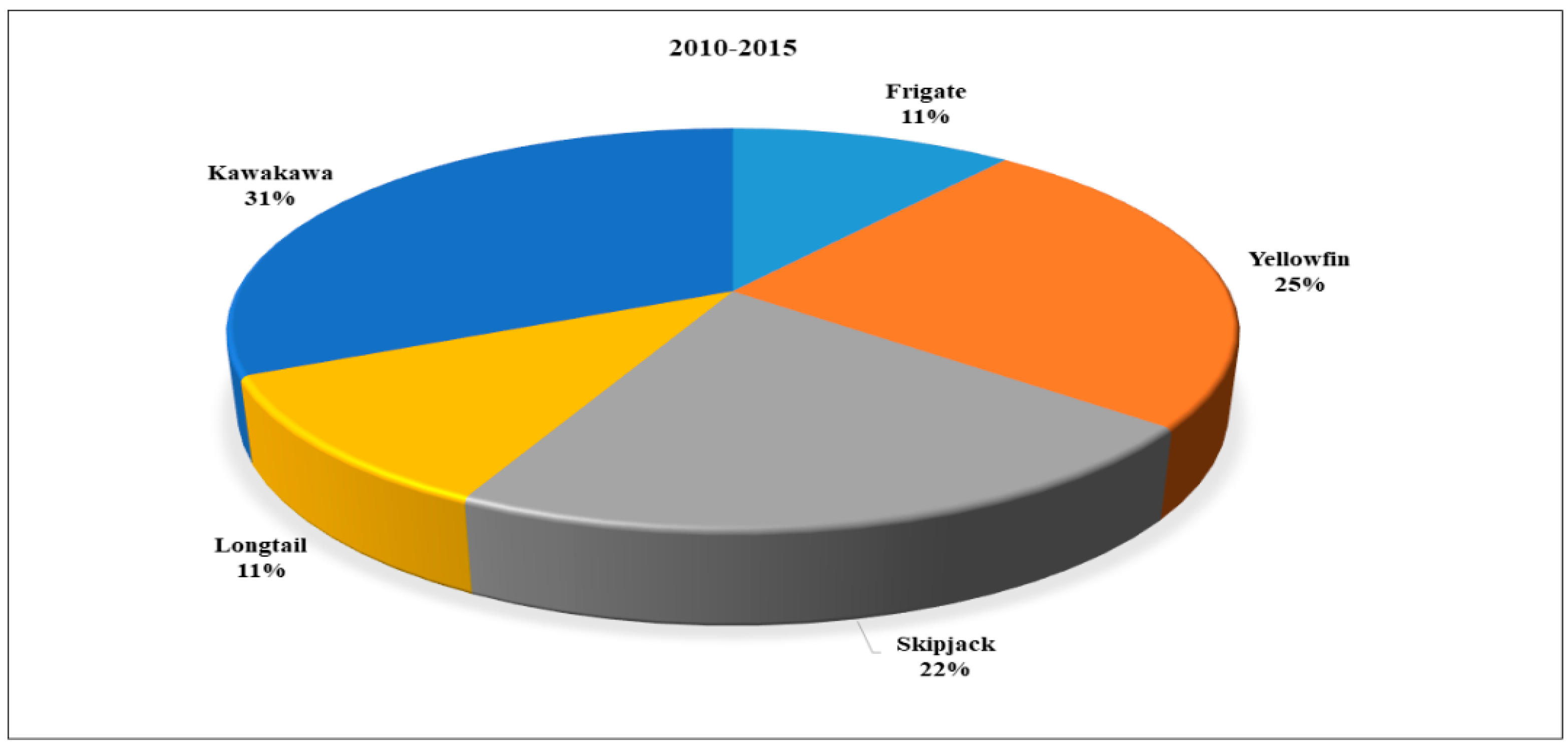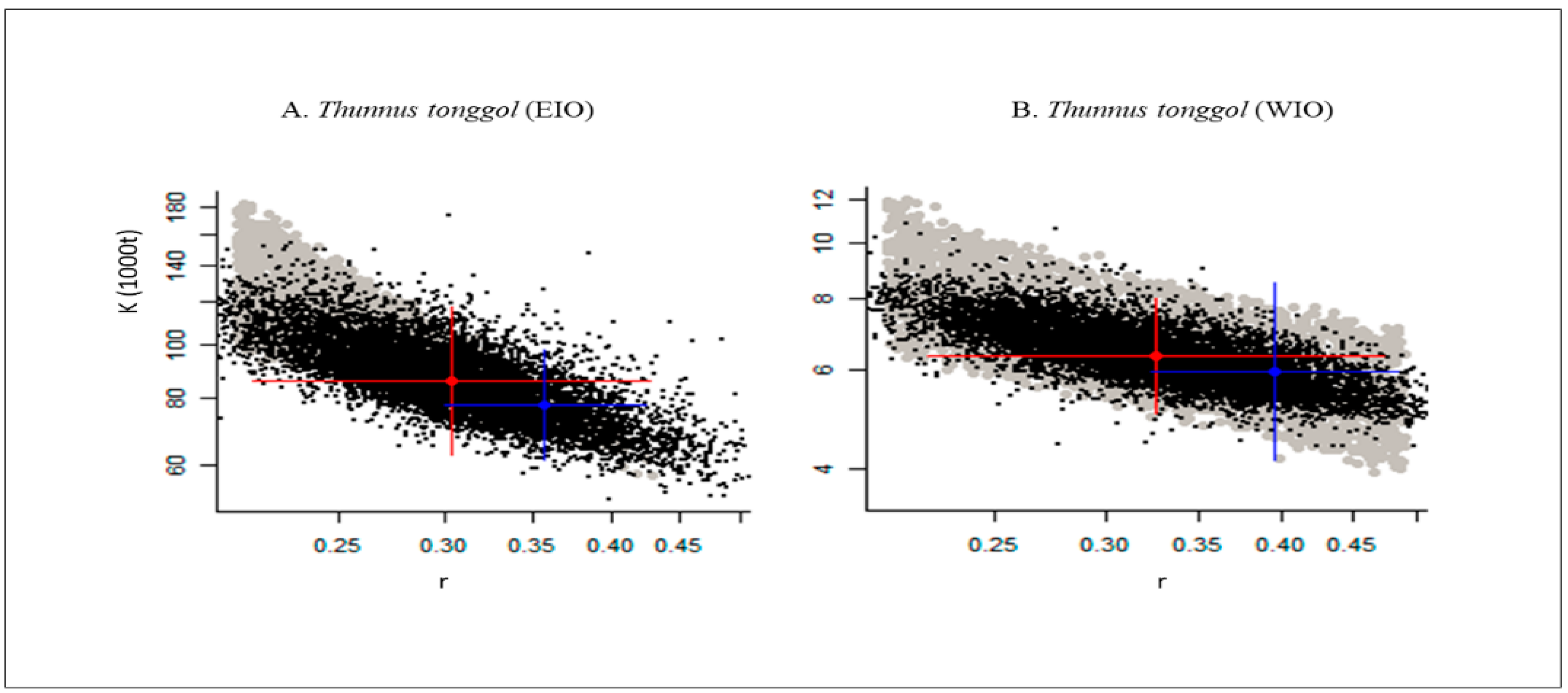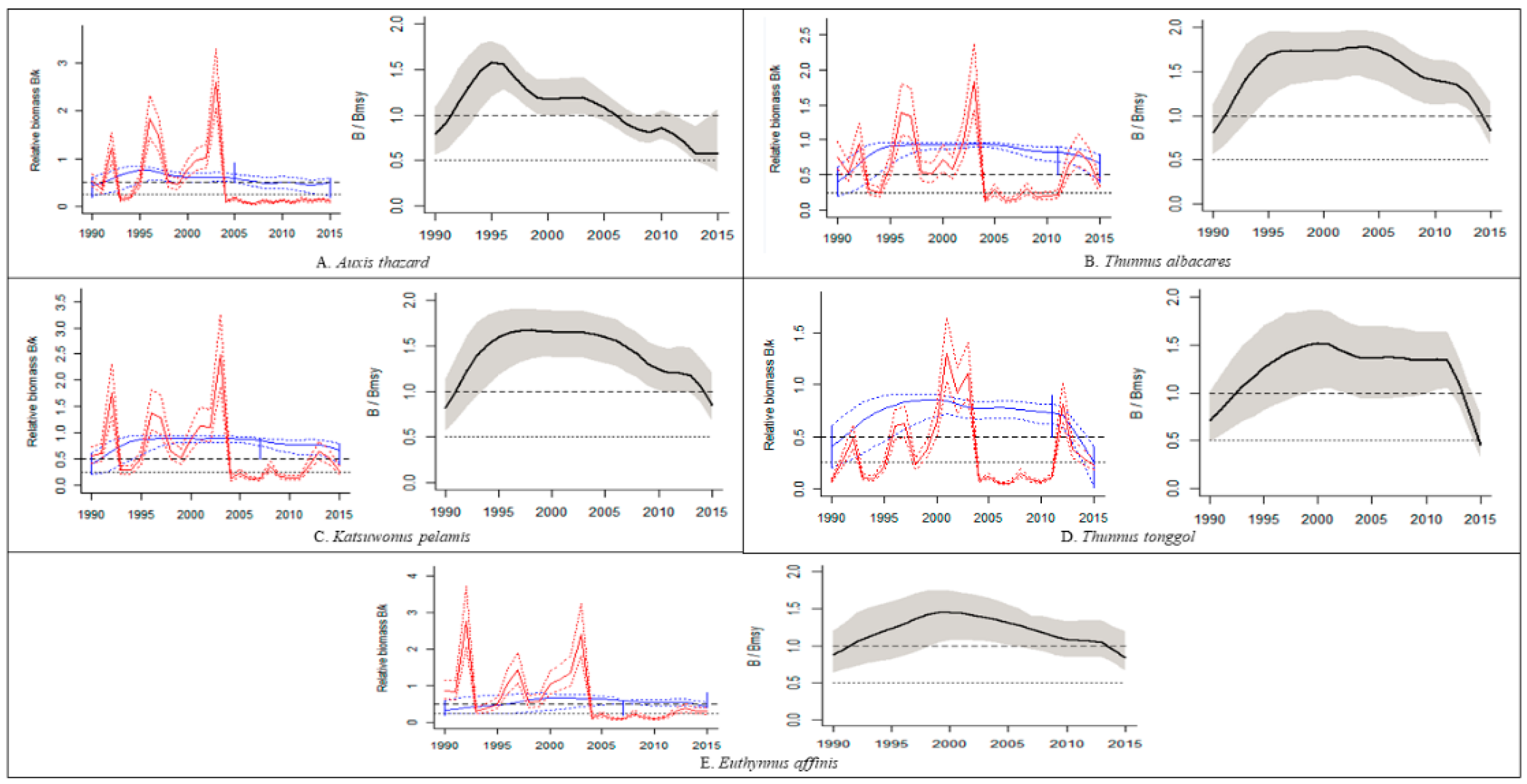Assessing Five Major Exploited Tuna Species in India (Eastern and Western Indian Ocean) Using the Monte Carlo Method (CMSY) and the Bayesian Schaefer Model (BSM)
Abstract
:1. Introduction
2. Materials and Methods
Stock Assessment by IOTC Using CMSY and BSM Models
3. Results
4. Discussion
5. Conclusions
Author Contributions
Funding
Institutional Review Board Statement
Informed Consent Statement
Data Availability Statement
Acknowledgments
Conflicts of Interest
References
- FAO. The State of World Fisheries and Aquaculture (SOFIA) 2018: Meeting the Sustainable Development Goals. Available online: https://www.fao.org/state-of-fisheries-aquaculture/2018/en (accessed on 10 January 2021).
- Pauly, D.; Zeller, D. Catch reconstructions reveal that global marine fisheries catches are higher than reported and declining. Nat. Commun. 2016, 7, 10244. [Google Scholar] [CrossRef]
- Pauly, D.; Zeller, D. Agreeing with FAO: Comments on SOFIA 2018. Mar. Policy 2019, 100, 332–333. [Google Scholar] [CrossRef]
- FAO. The State of World Fisheries and Aquaculture (SOFIA) 2020. Available online: http://www.fao.org/publications/sofia/2020/en/ (accessed on 10 January 2021).
- Lam, V.W.Y.; Pauly, D. Status of fisheries in 13 Asian large marine ecosystems. Deep Sea Res. Part II Top. Stud. Oceanogr. 2019, 163, 57–64. [Google Scholar] [CrossRef]
- Watson, R.A.; William, W.L.C.; Anticamara, J.A.; Sumaila, R.U.; Zeller, D.; Pauly, D. Global marine yield halved as fishing intensity redoubles. Fish Fish. 2013, 14, 493–503. [Google Scholar] [CrossRef]
- Myers, R.A.; Worm, B. Rapid worldwide depletion of predatory fish communities. Nature 2003, 423, 280–283. [Google Scholar] [CrossRef]
- Arkhipkin, A.I.; Rodhouse, P.G.; Pierce, G.J.; Sauer, W.; Sakai, M.; Allcock, L.; Arguelles, J.; Bower, J.R.; Castillo, G.; Ceriola, L.; et al. World squid fisheries. Rev. Fish. Sci. Aquac. 2015, 23, 92–252. [Google Scholar] [CrossRef] [Green Version]
- Southeast Asian State of Fisheries and Aquaculture (SEASOFIA) 2017. Available online: http://www.seafdec.org/documents/2017/03/49cm (accessed on 8 March 2021).
- IUCN Red List of Threatened Species. 2011. Version 2011.1. Available online: http://www.iucnredlist.org (accessed on 15 April 2021).
- FAO. Indian Ocean Tuna Commission (IOTC). 2020. Available online: https://www.iotc.org/science (accessed on 3 March 2021).
- Brunel, T.; Coelho, R.; Merino, G.; Ortiz de Urbina, J.; Rosa, D.; Santos, C.; Macias, D. A Preliminary Stock Assessment for the Shortfin Mako Shark in the Indian Ocean Using Data Limited Approaches. 2018. Available online: http://www.iotc.org (accessed on 28 December 2020).
- Kang, J.S. Analysis on the development trends of capture fisheries in North-East Asia and the policy and management implications for regional cooperation. Ocean Coast. Manag. 2006, 49, 42–67. [Google Scholar] [CrossRef]
- Asada, Y. License limitation regulations: The Japanese system. J. Fish. Board Can. 1973, 30, 2085–2095. [Google Scholar] [CrossRef]
- Lee, K.N.; Gates, J.M.; Lee, J.B. Recent developments in Korean fisheries management. Ocean Coast. Manag. 2006, 49, 355–366. [Google Scholar]
- Shen, G.; Heino, M. An overview of marine fisheries management in China. Mar. Policy 2014, 44, 265–272. [Google Scholar] [CrossRef] [Green Version]
- Melnychuk, M.C.; Peterson, E.; Elliott, M.; Hilborn, R. Fisheries management impacts on target species status. Proc. Natl. Acad. Sci. USA 2017, 114, 178–183. [Google Scholar] [CrossRef] [PubMed] [Green Version]
- Ludwig, D.; Hilborn, R.; Walters, C. Uncertainty, resource exploitation, and conservation: Lessons from history. Ecol. Appl. 1993, 3, 548–549. [Google Scholar] [CrossRef]
- Schaefer, M.B. Some aspects of the dynamics of populations important to the management of the commercial marine fisheries. Int. Am. Trop. Tuna Comm. Bull. 1954, 1, 23–56. [Google Scholar]
- Martell, S.; Froese, R. A simple method for estimating MSY from catch and resilience. Fish Fish. 2013, 14, 505–514. [Google Scholar] [CrossRef]
- Cope, J.; Punt, A.E. Length-based reference points for data-limited situations: Applications and restrictions. Mar. Coast. Fish. 2009, 1, 169–186. [Google Scholar] [CrossRef]
- MacCall, A.D. Depletion-corrected average catch: A simple formula for estimating sustainable yields in data-poor situations. ICES J. Mar. Sci. 2009, 66, 2267–2271. [Google Scholar] [CrossRef]
- Dick, E.J.; MacCall, A.D. Depletion-based stock reduction analysis: A catch-based method for determining sustainable yields for data-poor fish stocks. Fish. Res. 2011, 110, 331–341. [Google Scholar] [CrossRef]
- Rosenberg, A.A.; Fogarty, M.J.; Cooper, A.B.; Dickey-Collas, M.; Fulton, E.A.; Gutiérrez, N.L.; Hyde, K.J.; Kleisner, K.M.; Kristiansen, T.; Longo, C.; et al. Developing New Approaches to Global Stock Status Assessment and Fishery Production Potential of the Seas; FAO Fisheries and Aquaculture Circular No. 1086 FIRF/C1086; FAO: Rome, Italy, 2014. [Google Scholar]
- Froese, R.; Demirel, N.; Coro, G.; Kleisner, K.M.; Winker, H. Estimating fisheries reference points from catch and resilience. Fish Fish. 2017, 18, 506–526. [Google Scholar] [CrossRef] [Green Version]
- Thorson, J.T.; Ono, K.; Munch, S.B. A Bayesian approach to identifying and compensating for model misspecification in population models. Ecology 2014, 95, 329–341. [Google Scholar] [CrossRef] [Green Version]
- Plummer, M. JAGS: A program for analysis of Bayesian graphical models using Gibbs sampling. In Proceedings of the 3rd International Workshop on Distributed Statistical Computing (DSC 2003), Vienna, Austria, 20–22 March 2003; Vienna Technical University: Vienna, Austria, 2003. [Google Scholar]
- Beverton, R.J.H.; Holt, S.J. On the Dynamics of Exploited Fish Populations; Great Britain Ministry of Agriculture, Fisheries and Food: London, UK, 1957.
- Fishbase. Available online: http://www.fishbase.org (accessed on 5 January 2021).
- SeaLifeBase. Available online: http://www.sealifebase.org (accessed on 17 January 2021).
- McAllister, M.K.; Pikitch, E.K.; Babcock, E.A. Using demographic methods to construct Bayesian priors for the intrinsic rate of increase in the Schaefer model and implications for stock rebuilding. Can. J. Fish. Aquat. Sci. 2001, 58, 1871–1890. [Google Scholar] [CrossRef]
- Pauly, D.; Christensen, V.; Guénette, S.; Pitcher, T.J.; Sumaila, U.R.; Walters, C.J.; Watson, R.; Zeller, D. Towards sustainability in world fisheries. Nature 2002, 418, 689–695. [Google Scholar] [CrossRef] [PubMed]
- Tian, Y. Interannual–interdecadal variations of spear squid Loligo bleekeri abundance in the southwestern Japan Sea during 1975–2006: Impact of the trawl fishing and recommendations for management under the different climate regimes. Fish. Res. 2009, 100, 78–85. [Google Scholar] [CrossRef]
- FAO. The State of World Fisheries and Aquaculture (SOFIA) 2016. Available online: http://www.fao.org/documents/card/en/c/2c8bcf47-2214-4aeb-95b0-62ddef8a982a/7 (accessed on 17 February 2021).
- Palomares, M.L.D.; Froese, R.; Derrick, B.; Nöel, S.-L.; Tsui, G.; Woroniak, J.; Pauly, D. A preliminary global assessment of the status of exploited marine fish and invertebrate populations. In A Report Prepared by the Sea around Us for OCEANA; OCEANA: Washington, DC, USA, 2018; p. 60. [Google Scholar]
- Froese, R.; Pauly, D. Fishbase. Wide Web Electronic Publication. 2015. Available online: http://www.fishbase.org (accessed on 18 January 2021).
- Pauly, D. Major trends in small-scale marine fisheries, with emphasis on developing countries, and some implications for the social sciences. Mar. Stud. 2006, 4, 7–22. [Google Scholar]
- Harley, S.; Nick, D.; Hampton, J.; McKechnie, S. Stock Assessment of Bigeye Tuna in the Western and Central Pacific Ocean. In Proceedings of the Scientific Committee Tenth Regular Session, Majuro, Marshall Islands, 6–14 August 2014. WCPFC-SC10-2014/SAWP-01. [Google Scholar]
- Harley, S.; Williams, P.; Nicol, S.; Hampton, J. The Western and Central Pacific Tuna fishery: 2010 Overview and Status of stocks; Tuna Fisheries Assessment Report No. 11; Secretariat of the Pacific Community: Noumea, New Caledonia, 2011; Volume 37. [Google Scholar]
- Costello, C.; Ovando, D.; Hilborn, R.; Gaines, S.D.; Deschenes, O.; Lester, S.E. Status and solutions for the world’s unassessed fisheries. Science 2012, 338, 517–520. [Google Scholar] [CrossRef] [PubMed] [Green Version]
- Costello, C.; Ovando, D. Status, institutions, and prospects for global capture fisheries. Ann. Rev. Environ. Resour. 2019, 44, 177–200. [Google Scholar] [CrossRef]
- Hilborn, R.; Walters, C.J. Quantitative fisheries stock assessment: Choice, dynamics and uncertainty. Rev. Fish Biol. Fish. 1992, 2, 177–178. [Google Scholar]
- Baset, A.; Liu, Q.; Hanif, M.T.; Liao, B.; Mahmood, A.M.; Mohsin, M. Estimation of Maximum Sustainable Yield Using Production Modeling: A Stock Appraisal of Indian Oil Sardine (Sardinella longiceps) from Pakistani Waters. Pak. J. Zool. 2017, 49, 485–492. [Google Scholar] [CrossRef]
- Ji, Y.; Liu, Q.; Liao, B.; Zhang, Q.; Han, Y.N. Estimating biological reference points for Large head hairtail (Trichiurus lepturus) fishery in theYellow Sea and Bohai Sea. Acta Oceanol. Sin. 2019, 38, 20–26. [Google Scholar] [CrossRef]
- Khatun, M.H.; Lupa, S.T.; Rahman, M.F.; Barman, P.P.; Liu, Q. Evaluation of Labeo calbasu Fishery Status Using Surplus Production Models in Kaptai Reservoir, Bangladesh. Appl. Ecol. Environ. Res. 2019, 17, 2519–2532. [Google Scholar] [CrossRef]
- Gattuso, J.P.; Magnan, A.K.; Bopp, L.; Cheung, W.W.; Duarte, C.M.; Hinkel, J.; Mcleod, E.; Micheli, F.; Oschlies, A.; Williamson, P.; et al. Ocean solutions to address climate change and its effects on marine ecosystems. Front. Mar. Sci. 2018, 5, 337. [Google Scholar] [CrossRef] [Green Version]
- Sumaila, U.R.; Tai, T.C. End Overfishing and Increase the Resilience of the Ocean to Climate Change. Front. Mar. Sci. 2020, 7, 523. [Google Scholar] [CrossRef]
- ICES. Report of the fifth workshop on the development of quantitative assessment methodologies based on life-history traits. In Exploitation Characteristics and Other Relevant Parameters for Data-limited Stocks (WKLIFE V); International Council for the Exploration of the Sea: Lisbon, Portugal, 2015; Volume 56, p. 157. [Google Scholar]
- Hoggarth, D.D.; Abeyasekera, S.; Arthur, R.I.; Beddington, J.R.; Burn, R.W.; Halls, A.S.; Kirkwood, G.P.; McAllister, M.; Medley, P.; Mees, C.C.; et al. Stock Assessment for Fishery Management—A Framework Guide to the Stock Assessment Tools of the Fisheries Management Science Programme; FAO Fisheries Technical Paper 487; FAO: Rome, Italy, 2006. [Google Scholar]
- Dan, F. Assessment of Indian Ocean Longtail Tuna (Thunnus tonggol) Using Data-Limited Methods. 2020. Available online: http://www.iotc.org/longtailtuna.en (accessed on 27 July 2021).
- Dan, F. Assessment of Indian Ocean Kawakawa (Euthynnus affinis) Using Data-Limited Methods. 2020. Available online: http://www.iotc.org/kawakawa.en (accessed on 27 July 2021).




| Species | Region | Habitat | Exploited Country | Data Year | Reference | |
|---|---|---|---|---|---|---|
| Catch | Effort | |||||
| Auxis thazard (Frigate tuna) | Eastern Indian Ocean | Pelagic-neritic | India | 1990–2015 | 1990–2015 | Catch on FishstatJ [1] Effort on [12] |
| Western Indian Ocean | Pelagic-neritic | India | 1990–2015 | 1990–2015 | Catch on FishstatJ [1] Effort on [12] | |
| Thunnus albacares (Yellowfin tuna) | Eastern Indian Ocean | Pelagic-ceanic | India | 1990–2015 | 1990–2015 | Catch on FishstatJ [1] Effort on [12] |
| Western Indian Ocean | Pelagic-ceanic | India | 1990–2015 | 1990–2015 | Catch on FishstatJ [1] Effort on [12] | |
| Katsuwonus pelamis (Skipjack tuna) | Eastern Indian Ocean | Pelagic-ceanic | India | 1990–2015 | 1990–2015 | Catch on FishstatJ [1] Effort on [12] |
| Western Indian Ocean | Pelagic-ceanic | India | 1990–2015 | 1990–2015 | Catch on FishstatJ [1] Effort on [12] | |
| Thunnus tonggol (Longtail tuna) | Eastern Indian Ocean | Pelagic-neritic | India | 1990–2015 | 1990–2015 | Catch on FishstatJ [1] Effort on [12] |
| Western Indian Ocean | Pelagic-neritic | India | 1990–2015 | 1990–2015 | Catch on FishstatJ [1] Effort on [12] | |
| Euthynnus affinis (Kawakawa) | Eastern Indian Ocean | Pelagic-neritic | India | 1990–2015 | 1990–2015 | Catch on FishstatJ [1] Effort on [12] |
| Western Indian Ocean | Pelagic-neritic | India | 1990–2015 | 1990–2015 | Catch on FishstatJ [1] Effort on [12] | |
| Resilience Category | r Range | Stock |
|---|---|---|
| High | 0.6–1.5 | None |
| Medium | 0.2–0.8 | A. thazard, T. albacares, K. pelamis, E. affinis |
| Low | 0.05–0.5 | T. tonggol |
| Very low | 0.015–0.1 | None |
| Prior Biomass | B/k | Stock | Stock | ||
|---|---|---|---|---|---|
| Eastern Indian Ocean | Western Indian Ocean | ||||
| Bstart/k | Bend/k | Bstart/k | Bend/k | ||
| Low | 0.01–0.4 | None | A. thazard, K. pelamis | None | T. tonggol |
| 0.01–0.2 | None | None | None | None | |
| Medium | 0.2–0.6 | A. thazard, T. albacares, K. pelamis, T. tonggol, E. affinis | None | A. thazard, T. albacares, K. pelamis, T. tonggol, E. affinis | A. thazard |
| High | 0.5–0.9 | None | T. albacares, T. tonggol, E. affinis | None | T. albacares, K. pelamis, E. affinis |
| 0.8–1.0 | None | None | None | None | |
| Very high | 0.9–1.0 | None | None | None | None |
| Stock Status | B/BMSY |
|---|---|
| Healthy | ≥1.0 |
| Overfished | 0.5–1.0 |
| Strongly overfished | 0.2–0.5 |
| Collapsed | 0.0–0.2 |
| STOCK | r | k (103 t) | MSY (103 YEAR−1) | B/BMSY |
|---|---|---|---|---|
| A. thazard | 0.872 (0.656–1.16) | 19.2 (14.9–24.6) | 4.17 (3.88–4.48) | 0.557 (0.362–0.879) |
| T. albacares | 0.644 (0.445–0.932) | 42.8 (33.1–55.3) | 6.89 (5.49–8.65) | 0.822 (0.659–1.15) |
| K. pelamis | 0.563 (0.399–0.793) | 14 (11.8–16.6) | 1.97 (1.57–2.48) | 0.634 (0.532–0.741) |
| T. tonggol | 0.304 (0.216–0.428) | 86.2 (63–118) | 6.56 (5.21–8.25) | 0.814 (0.649–1.16) |
| E. affinis | 0.592 (0.421–0.833) | 46.1 (34.5–61.5) | 6.82 (5.79–8.03) | 0.83 (0.665–1.18) |
| STOCK | r | k (103 t) | MSY (103 YEAR−1) | B/BMSY |
|---|---|---|---|---|
| A. thazard | 0.886 (0.676–1.16) | 35.1 (27.6–44.6) | 7.77 (7.24–8.34) | 0.572 (0.377–1.07) |
| T. albacares | 0.634 (0.434–0.928) | 79 (60.9–102) | 12.5 (9.88–15.9) | 0.823 (0.66–1.16) |
| K. pelamis | 0.639 (0.45–0.907) | 97.4 (74.1–128) | 15.6 (12.7–19) | 0.843 (0.667–1.2) |
| T. tonggol | 0.326 (0.224–0.473) | 6.35 (5.02–8.03) | 0.517 (0.402–0.665) | 0.448 (0.307–0.781) |
| E. affinis | 0.611 (0.436–0.855) | 133 (99.1–178) | 20.3 (17.5–23.5) | 0.836 (0.662–1.19) |
| Stock | Result of CMSY Analysis | Result of BSM Analysis | ||||
|---|---|---|---|---|---|---|
| r | k (103 t) | MSY (103 year−1) | r | k (103 t) | MSY (103 year−1) | |
| A. thazard | 0.689 (0.566–0.839) | 23.7 (18.5–30.2) | 4.07 (3.7–4.48) | 0.872 (0.656–1.16) | 19.2 (14.9–24.6) | 4.17 (3.88–4.48) |
| T. albacares | 0.689 (0.566–0.839) | 63.4 (38.6–104) | 10.9 (6.07–19.6) | 0.644 (0.445–0.932) | 42.8 (33.1–55.3) | 6.89 (5.49–8.65) |
| K. pelami | 0.689 (0.566–0.839) | 11.4 (8.24–15.9) | 1.97 (1.52–2.55) | 0.563 (0.399–0.793) | 14 (11.8–16.6) | 1.97 (1.57–2.48) |
| T. tonggol | 0.356 (0.275–0.462) | 77.5 (61.4–97.9) | 6.9 (6.08–7.84) | 0.304 (0.216–0.428) | 86.2 (63–118) | 6.56 (5.21–8.25) |
| E. affinis | 0.689 (0.566–0.839) | 40.6 (31.2–52.8) | 6.99 (6.14–7.97) | 0.592 (0.421–0.833) | 46.1 (34.5–61.5) | 6.82 (5.79–8.03) |
| Stock | Result of CMSY Analysis | Result of BSM Analysis | ||||
|---|---|---|---|---|---|---|
| r | k (103 t) | MSY (103 year−1) | r | k (103 t) | MSY (103 year−1) | |
| A. thazard | 0.689 (0.566–0.839) | 46.4 (35.4–60.9) | 8 (6.91–9.25) | 0.886 (0.676–1.16) | 35.1 (27.6–44.6) | 7.77 (7.24–8.34) |
| T. albacares | 0.689 (0.566–0.839) | 115 (69.4–190) | 19.8 (10.8–36.1) | 0.634 (0.434–928) | 79 (60.9–102) | 12.5 (9.88–15.9) |
| K. pelamis | 0.689 (0.566–0.839) | 132 (82.5–212) | 22.8 (13.3–39.1) | 0.639 (0.45–0.907) | 97.4 (74.1–128) | 15.6 (12.7–19) |
| T. tonggol | 0.396 (0.323–0.484) | 5.95 (4.14–8.55) | 0.588 (0.429–806) | 0.326 (0.224–0.473) | 6.35 (5.02–8.03) | 0.517 (0.402–0.665) |
| E. affinis | 0.689 (0.566–0.839) | 122 (89.8–165) | 21 (17–25.9) | 0.611 (0.436–0.855) | 133 (99.1–178) | 20.3 (17.5–23.5) |
Publisher’s Note: MDPI stays neutral with regard to jurisdictional claims in published maps and institutional affiliations. |
© 2021 by the authors. Licensee MDPI, Basel, Switzerland. This article is an open access article distributed under the terms and conditions of the Creative Commons Attribution (CC BY) license (https://creativecommons.org/licenses/by/4.0/).
Share and Cite
Nisar, U.; Ali, R.; Mu, Y.; Sun, Y. Assessing Five Major Exploited Tuna Species in India (Eastern and Western Indian Ocean) Using the Monte Carlo Method (CMSY) and the Bayesian Schaefer Model (BSM). Sustainability 2021, 13, 8868. https://doi.org/10.3390/su13168868
Nisar U, Ali R, Mu Y, Sun Y. Assessing Five Major Exploited Tuna Species in India (Eastern and Western Indian Ocean) Using the Monte Carlo Method (CMSY) and the Bayesian Schaefer Model (BSM). Sustainability. 2021; 13(16):8868. https://doi.org/10.3390/su13168868
Chicago/Turabian StyleNisar, Ubair, Rafiya Ali, Yongtong Mu, and Yu Sun. 2021. "Assessing Five Major Exploited Tuna Species in India (Eastern and Western Indian Ocean) Using the Monte Carlo Method (CMSY) and the Bayesian Schaefer Model (BSM)" Sustainability 13, no. 16: 8868. https://doi.org/10.3390/su13168868
APA StyleNisar, U., Ali, R., Mu, Y., & Sun, Y. (2021). Assessing Five Major Exploited Tuna Species in India (Eastern and Western Indian Ocean) Using the Monte Carlo Method (CMSY) and the Bayesian Schaefer Model (BSM). Sustainability, 13(16), 8868. https://doi.org/10.3390/su13168868






